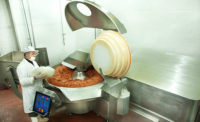

* even distribution of different meat and non-meat ingredients;
* proper mechanical action and temperatures for extracting protein (if protein bind is desirable); and
* proper mechanical action for maintaining optimal particle definition (if particle definition is desired).
There are two main types of agitators ” ribbons and paddles ” to consider. Although many companies have used ribbon mixers in the past, paddle mixers are more desirable for most meat mixing applications. Paddle mixers are more efficient in uniformly mixing two or more ingredients. Compared to ribbon agitators, paddle agitators provide more lift and less push to product, which results in less compaction of ground meat, and paddle agitators are preferred when mixing high-viscosity mixtures, such as very cold meat or drier meat blends, such as ground beef, fresh sausage and dry sausage.
Paddles are typically self-cleaning during the mixing process, so fat build-up is less of a problem. Intermeshing of paddle agitators speeds up the mixing process, reducing the mixing time needed to produce a uniform mixture, which is particularly important when trying to mix in a lot of different non-meat ingredients into meat. This reduced mixing time should also reduce fat smearing for products in which particle definition is important.
Whereas there is some debate about this issue, many believe that paddle mixers would be more effective for extracting protein for mixing lean meat for pre-blends or for mixing blends prior to emulsification. However, I know of little scientific data to support either argument. If the surface area of the paddles moving through the product is increased, by either using larger paddles or more, smaller paddles, the mechanical action of meat working against meat is increased, which increases protein extraction.
Paddle mixers run at reduced rpms, which can be useful for applying mechanical action to whole-muscle pieces or softer poultry muscle to produce a surface protein exudate without damaging muscle integrity. Single shaft paddle agitators are also used in massagers to produce protein exudate and increase water-holding capacity of muscle pieces.
Ribbon mixers are less effective than paddle mixers in evenly distributing different ingredients that are added to the mixer, unless paddles are added between the shaft and the ribbon. Regarding the protein extraction debate in blends intended for cooked or emulsified sausage, some claim that ribbon agitators are more effective than paddles due to the friction produced during ribbon mixing. The ribbon speed would need to be increased to get sufficient turbulence to sufficiently extract protein.
Ribbon mixers can cause compaction of drier blends, such as ground beef, fresh sausage and dry sausage. Ribbons can also cause “log” or “barrel rolling,” which results in meat packing around the shaft and turning around the shaft with no mixing action. This is particularly a problem when water is added to frozen meat in a mixer. Fat build-up is also a bigger problem on ribbon agitators than on paddles.
Fat smearing can be a problem with ribbon agitators, because of the meat being slid along the sides of the mixer and pinch points between ribbons and at the ends of the ribbons, particularly if product temperature is too warm.
In addition to the type of agitator, mixing times and temperatures are also very important in getting proper protein extraction, particle definition and final product texture. Mixing times for hamburger and sausage patties, as well as for fermented and dried products would be shorter than for cooked sausages, because protein extraction is not important in making these products. Also, for hamburger and sausage patties, over-mixing will result in an undesirable, rubbery texture and possibly fat smearing. For all of these products, colder meat temperatures will help to minimize melting of the fat, and therefore, fat smearing.
For cooked sausage products, where protein extraction is important, the lean portion should be mixed as long as is feasible at the coldest temperatures possible, with the salt (and phosphate, if used), to optimize protein extraction. When the fattier ingredients are added, mixing time should be minimized and product temperatures kept as cold as possible to minimize fat smearing.
When determining the capacity of a mixer, at a minimum, the volume of meat should be at least up to the center shaft of the agitators. Meat should not extend past the tip of the agitators, for the maximum volume that a mixer can properly mix. Bridging can occur with over-filling of mixers, and proper mixing will not occur with under-filling. Vacuum mixing is very important to producing a high-quality product, and pulling a vacuum during mixing will compact the volume of meat in a mixer.
For most cooked products, vacuum mixing is important, but vacuum mixing would not be recommended for looser textured products, such as ground beef and sausage patties. Vacuum mixing removes air bubbles and pockets, which improves texture and appearance of cooked sausage products.
The sequence of final grinding vs. mixing will also impact product texture, and particle definition. For products in which good particle definition and a more crumbly texture is preferred, mixing should occur before the final grinding. For products in which a tighter texture and higher cooking yields are preferred, products should be mixed after the final grinding. Also, products which contain cheese, peppercorns, encapsulated citric acid, etc., should be final ground before these ingredients are mixed into the product, to prevent destroying these particles during the final grind.
Although there are many factors related to mixing that affect the quality of meat products, the stuffing or forming processes that follow mixing could result in texture or smearing problems.



Report Abusive Comment